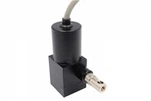Pressure sensor is the most commonly used sensor in industrial practice. It is widely used in various industrial automation environments, including water conservancy and hydropower, railway transportation, intelligent buildings, production automation, aerospace, military, petrochemical, oil wells, electricity, ships, Many industries such as machine tools and pipelines.
Pressure sensor Corrosion-resistant ceramic pressure sensor has no liquid transmission. The pressure directly acts on the front surface of the ceramic diaphragm, causing a slight deformation of the diaphragm. The thick film resistor is printed on the back of the ceramic diaphragm and connected to form a Wheatstone bridge. (Closed bridge), due to the piezoresistive effect of the varistor, the bridge generates a highly linear voltage signal proportional to the pressure and proportional to the excitation voltage. The standard signal is calibrated to 2.0 / 3.0 according to the pressure range. / 3.3 mV/V, etc., compatible with strain gauge sensors. Through laser calibration, the sensor has high temperature stability and time stability. The sensor comes with a temperature compensation of 0 to 70 ℃, and can be in direct contact with most media.
Ceramic is a recognized material with high elasticity, corrosion resistance, wear resistance, shock and vibration resistance. The thermal stability of ceramics and its thick film resistors can make its operating temperature range as high as -40 ~ 135 ℃, and it has high accuracy and high stability of measurement. The electrical insulation level is 2kV, the output signal is strong, the long-term stability is good, the high characteristic, the low price ceramic sensor will be the development direction of the pressure sensor. There is a trend to replace other types of sensors in European and American countries, and more and more in China Of users use ceramic sensors instead of diffused silicon pressure sensors.






